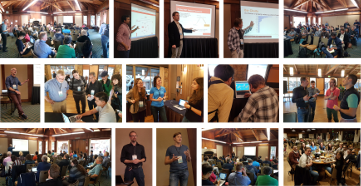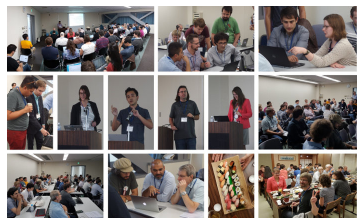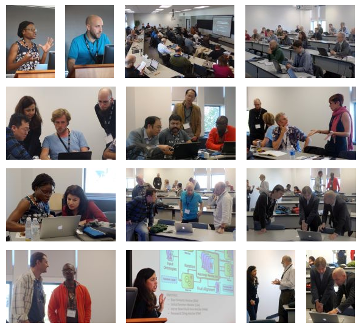Visualization and Interaction for Ontologies and Linked Data
3rd International Workshop co-located with ISWC 2017, October 22, 2017, Vienna, Austria

Announcement: VOILA 2019
VOILA! will take place again at ISWC 2019. Details can be found on the VOILA 2019 workshop website.
Motivation and Objectives
A picture is worth a thousand words, we often say, yet many areas are in demand of sophisticated visualization techniques, and the Semantic Web is not an exception. The size and complexity of ontologies and Linked Data in the Semantic Web constantly grows and the diverse backgrounds of the users and application areas multiply at the same time. Providing users with visual representations and intuitive interaction techniques can significantly aid the exploration and understanding of the domains and knowledge represented by ontologies and Linked Data.
Ontology visualization is not a new topic and a number of approaches have become available in recent years, with some being already well-established, particularly in the field of ontology modeling. In other areas of ontology engineering, such as ontology alignment and debugging, although several tools have been developed, few provide a graphical user interface, not to mention navigational aids or comprehensive visualization and interaction techniques.
In the presence of a huge network of interconnected resources, one of the challenges faced by the Linked Data community is the visualization of multidimensional datasets to provide for efficient overview, exploration and querying tasks, to mention just a few. With the focus shifting from a Web of Documents to a Web of Data, changes in the interaction paradigms are in demand as well. Novel approaches also need to take into consideration the technological challenges and opportunities given by new interaction contexts, ranging from mobile, touch, and gesture interaction to visualizations on large displays, and encompassing highly responsive web applications.
There is no one-size-fits-all solution but different use cases demand different visualization and interaction techniques. Ultimately, providing better user interfaces, visual representations and interaction techniques will foster user engagement and likely lead to higher quality results in different applications employing ontologies and proliferate the consumption of Linked Data.
Program
The workshop will take place at the campus of Vienna University of Economics and Business, Building TC, 1st floor, room TC.1.01.
9:00 - 9:15 Opening
9:15 - 10:30 Session I: Ontology Visualization & Ontology-Based Data Access
9:15 - 9:25 Ontology Reuse Decision Support: Visualize the Ontology or its Usage?
by Marek Dudáš and Vojtěch Svátek
9:25 - 9:40 Real Time Summarization and Visualization of Ontology Change in Protégé
by Christopher Ochs, James Geller, Mark A. Musen and Yehoshua Perl
9:40 - 9:55 User-friendly Visual Creation of R2RML Mappings in SQuaRE
by Jarosław Bąk, Michał Blinkiewicz and Agnieszka Ławrynowicz
9:55 - 10:10 Using a Block Metaphor for Representing R2RML Mappings (-> video)
by Ademar Crotti Junior, Christophe Debruyne and Declan O'Sullivan
Until 10:30 Discussion
10:30 - 11:00 Coffee break
11:00 - 12:20 Session II: Visualization & Exploration of the Web of Data
11:00 - 11:15 Towards the Design of Expressive Data Exploration Environments (-> video 1, video 2)
by Thiago Nunes and Daniel Schwabe
11:15 - 11:30 Customised Visualisations of Linked Open Data
by Alice Graziosi, Angelo Di Iorio, Francesco Poggi and Silvio Peroni
11:30 - 11:40 Visualizing Linked Data as Habitable Cities
by Klaas Andries de Graaf and Ali Khalili
11:40 - 11:55 A User Study of Techniques for Visualizing Structure and Connectivity in Hierarchical Datasets
by Tommy Dang, Paul Murray, Ronak Etemadpour and Angus G. Forbes
until 12:20 Discussion & Wrap-Up Morning
12:20 - 14:00 Lunch
14:00 - 15:30 Session III: Visual Querying & Browsing of Linked Data
14:00 - 14:15 IcicleQuery: A Web Search Interface for Fluid Semantic Query Construction
by Annett Mitschick, Franz Nieschalk, Martin Voigt and Raimund Dachselt
14:15 - 14:25 WYSIWYQ --- What You See Is What You Query (-> video)
by Ali Khalili and Albert Meroño-Peñuela
14:25 - 14:40 Extended UML Class Diagram Constructs for Visual SPARQL Queries in ViziQuer/web
by Kārlis Čerāns, Juris Bārzdiņš, Agris Šostaks, Jūlija Ovčiņņikova, Lelde Lāce, Mikus Grasmanis and Artūrs Sproģis
14:40 - 14:55 Phuzzy.link: A SPARQL-powered Client-Sided Extensible Semantic Web Browser
by Blake Regalia, Krzysztof Janowicz and Gengchen Mai
14:55 - 15:10 FaRBIE: A Faceted Reactive Browsing Interface for Multi RDF Knowledge Graph Exploration
by Luis Fuenmayor, Diego Collarana, Steffen Lohmman and Sören Auer
until 15:30 Discussion
15:30 - 16:00 Coffee break
16:00 - 17:00 Session IV: Demos
17:00 - 17:15 Wrap Up & Closing
Impressions
About 50 researchers and practitioners took part in the full-day event consisting of talks, discussions, and tool demonstrations. Here are some impressions from the workshop:
Proceedings
The workshop proceedings are published as CEUR-WS volume 1947.
V. Ivanova, P. Lambrix, S. Lohmann, C. Pesquita: Proceedings of the Third International Workshop on Visualization and Interaction for Ontologies and Linked Data (VOILA '17), Vienna, Austria. CEUR Workshop Proceedings, vol. 1947, CEUR-WS.org, 2017.
Topics of Interest
Topics, subjects, and contexts of interest include (but are not limited to):
- Topics:
- visualizations
- user interfaces
- visual analytics
- requirements analysis
- case studies
- user evaluations
- cognitive aspects
- Subjects:
- ontologies
- linked data
- ontology engineering (development, collaboration, ontology design patterns, alignment, debugging, evolution, provenance, etc.)
- Contexts:
- classical interaction contexts (desktop, keyboard, mouse, etc.)
- novel interaction contexts (mobile, touch, gesture, etc.)
- special settings (large, high-resolution, and multiple displays, etc.)
- specific user groups and needs (people with disabilities, domain experts, etc.)
Submission Guidelines
Paper submission and reviewing for this workshop will be electronic via EasyChair. The papers should be written in English, following the Springer LNCS format, and be submitted in either PDF or in HTML on or before July 27, 2017 (extended). All deadlines are midnight Hawaii time.
For details on the PDF submission format, see Springer's LNCS guidelines. For HTML submission guidance, see the HTML submission guide of ISWC 2017.
The following types of contributions are welcome. The recommended page length is given in brackets. There is no strict page limit but the length of a paper should be commensurate with its contribution.
- Full research papers (8-12 pages);
- Experience papers (8-12 pages);
- Position papers (6-8 pages);
- Short research papers (4-6 pages);
- System papers (4-6 pages).
It is recommended to include a (persistent) URL to a working implementation or an (annotated) screencast for submissions presenting interactive visualizations, user interfaces, tools, etc.
Accepted papers will be published as a volume in the CEUR Workshop Proceedings series. See CEUR-WS volume 1704 for the proceedings of last year's VOILA workshop.
Note that for the first time this year ISWC offers a registration *only* for the workshops and tutorials days. For details please visit the ISWC registration page.
Organizers
Patrick Lambrix, Linköping University, Sweden
Steffen Lohmann, Fraunhofer IAIS, Germany
Catia Pesquita, University of Lisbon, Portugal
Programme Committee
Benjamin Bach, Edinburgh University, UK
Isabel F. Cruz, University of Illinois at Chicago, USA
Aba-Sah Dadzie, Knowledge Media Institute, The Open University, UK
Aidan Delaney, University of Brighton, UK
Marek Dudáš, University of Economics, Prague, Czech Republic
Roberto García, Universitat de Lleida, Spain
Alain Giboin, Universitó Côte d'Azur, Inria, CNRS, I3S, France
Anika Groß, University of Leipzig, Germany
Willem Robert van Hage, Netherlands eScience Center, The Netherlands
Ali Hasnain, The Insight Centre for Data Analytics, Ireland
Eero Hyvönen, Aalto University & University of Helsinki, Finland
Tomi Kauppinen, Aalto University School of Science, Finland
Ali Khalili, Vrije Universiteit Amsterdam, The Netherlands
Paul Mulholland, Knowledge Media Institute, The Open University, UK
Stefan Negru, MSD IT Global Innovation Center, Czech Republic
Francesco Osborne, Knowledge Media Institute, The Open University, UK
Paul Parsons, Purdue University, USA
Silvio Peroni, University of Bologna, Italy
Emmanuel Pietriga, INRIA Saclay, France
Harald Sack, Leibniz Institute for Information Infrastructure & KIT Karlsruhe, Germany
Daniel Schwabe, Pontifical Catholic University of Rio de Janeiro, Brazil
Kamran Sedig, University of Western Ontario, Canada
Ahmet Soylu, Norwegian University of Science and Technology, Norway
Gem Stapleton, University of Brighton, UK
Markel Vigo, University of Manchester, UK
Simon Walk, Stanford University, USA
Important Dates
Abstract: July 14, 2017Submission: July 27, 2017Notification: August 24, 2017Camera-ready: September 11, 2017Workshop: October 22, 2017






